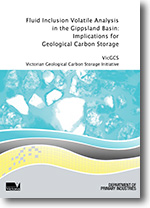VicGCS Report 6 - Fluid inclusion volatile analysis in the Gippsland Basin: Implications for geological carbon storage
 |
| |||||
Product description:Executive Summary This report outlines the results obtained from fluid inclusion stratigraphy (FIS) analysis on cutting samples from six wells within the Gippsland Basin and discusses implications for regional hydrocarbon migration. The results are considered from a geological carbon storage (GCS) perspective whereby past and present migration pathways indicate possible future pathways for CO2 injected into the subsurface. The FIS data derived from samples from Omeo-1, Barracouta-2, Devilfish-1, Golden Beach-1A, Wombat-3 and Salt Lake-1 show evidence for: (1) hydrocarbon presence within the Latrobe Group reservoirs; (2) horizons that act as intra-formational seals within the Latrobe Group; and (3) the presence of a largely adequate Lakes Entrance Formation regional seal (especially in offshore areas). FIS hydrocarbon responses are also detected in the Strzelecki Group onshore and associated liquid petroleum fluid inclusions observed. FIS signatures are detected through the Lakes Entrance Formation regional seal, such as in Golden Beach-1A (and possibly Omeo-1), while others observed above it - as opposed to through it - may suggest lithological controls and possible lateral migration into the Seaspray Group from proximal areas. Examples of the latter are observed in Barracouta-2 and Devilfish-1. In all cases, while FIS evidence for microseepage of hydrocarbons remains equivocal, due to the large periods of geological time over which fluid inclusions may have become trapped, integration of this new data into seal integrity maps and migration models will contribute significant input into regional GCS seal assessment evaluations. The present study provides a regional precompetitive evaluation of FIS as applied to the Gippsland Basin, and forms a basis from which further application of this technique may be used to progress GCS site characterisation activities in other parts of the basin. Download The downloadable version of this report is supplied in PDF format and is a large file (42.9MB). The accompanying Appendix 3 - FIS Reports for Devilfish-1, Omeo-1, Barracouta-2, Golden Beach-1A, Wombat-3 & Salt Lake-1 are also available for download and are supplied in PDF format as a large zip file (20.8MB). Bibliographic Reference MIRANDA, J.A., HALL, D.L., PHIUKHAO, W., O'BRIEN, G.W., GOLDIE DIVKO, L.M., CAMPI, M.J. & TINGATE, P.R., 2012. Fluid inclusion volatile analysis in the Gippsland Basin: Implications for geological carbon storage. GeoScience Victoria VicGCS report 6. Department of Primary Industries. | ||||||

